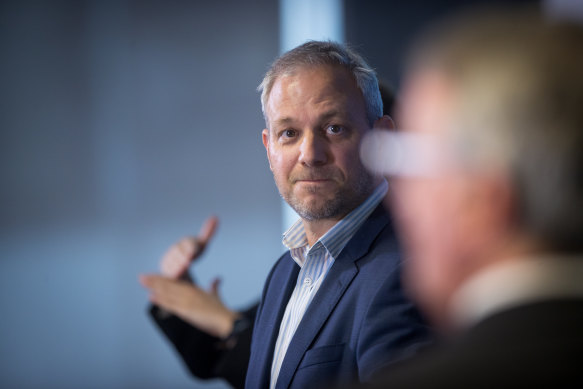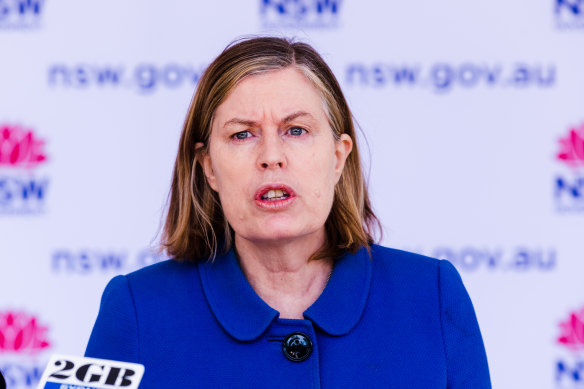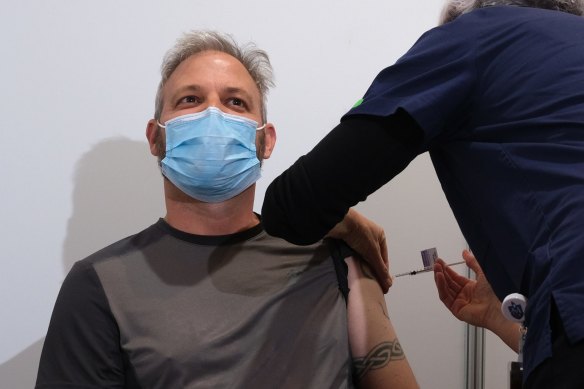Brett Sutton didn’t do a public health press conference for 10 months

Save articles for later
Add articles to your saved list and come back to them any time.
Key points
- The chief health officer’s communications have been largely confined to written statements in 2023.
- Experts say a lack of official messaging on COVID-19 is contributing to the spread of misinformation.
- In the past week, 51 COVID-19 deaths were reported in Victoria.
Victoria’s outgoing chief health officer Brett Sutton will leave the job this month and two of his deputies have also quit, as experts argue the state’s COVID messaging has been inadequate, leaving Victorians to their own devices while people continue to die from the virus.
Sutton did not do a press conference for the 10 months leading up to his resignation announcement – but the Andrews government denies he was blocked from speaking publicly.
In 2023, Brett Sutton’s public health messages have been mostly confined to written statements.Credit: Simon Schluter
About 3200 COVID deaths were reported in Victoria from Sutton’s last COVID press conference on August 1, 2022, until the day he resigned on June 9 this year. On Tuesday, the Victorian government confirmed he would finish in the role on July 28.
Victoria’s public health workforce is enduring ongoing and significant job cuts that leaders have claimed leave the state vulnerable. The health department repeatedly rejected media requests to interview the chief health officer over the past year on subjects ranging from the state of the pandemic to coronavirus deaths and vaccination status.
This year, Sutton’s public health messages have been mostly confined to written statements, including a weekly COVID-19 update.
The chief health officer was a regular Twitter user during the pandemic but, aside from retweets of health department tweets, there hasn’t been a message from his account since March. The relationship between Sutton and the government was strained at times during the pandemic.
When asked directly if Sutton had been gagged, a spokesman for the Victorian Health Minister Mary-Anne Thomas said “no” and pointed to an ABC radio interview on June 9 in which Sutton was asked if he had been silenced and answered: “not that I’m aware of”. Sutton did not respond to a request for comment for this story.
After accepting his Victorian of the Year award in a private capacity, Sutton told this masthead he was still keen to promote public health messages.
“I’m always happy to. And I am keen to. My weekly messages are out there, they will continue to be out there, and I’m happy to promote them,” Sutton said on June 30.
Two of his deputies – associate professor Deborah Friedman, an expert in communicable disease, and associate professor Angie Bone, an expert in environmental public health issues – have recently announced they will move onto new roles.
Friedman will become the new director of the Victorian Coordinating Centre for Healthcare Associated Infections and Bone is taking on a role at the Monash Sustainable Development Institute.
The head of La Trobe University’s Centre for Health Communication and Participation, Dr Rebecca Ryan, said there may be a valid argument that Sutton was no longer the right person to regularly front the media. That’s because while some Victorians admired his work, for others he represented the worst time in the pandemic.
However, if it wasn’t Sutton, she said another health leader needed to honestly communicate about the danger COVID still posed, who was most at risk, and the steps people might take to help protect themselves and others.
“Ten months [without a COVID-19 press conference] is a long time. We’re not just talking about scaling it back to once every second week or once a month, it’s just sort of been a void. And I think that has really done a disservice to everyone because COVID is still killing 200 people in Australia a week nearly, on and off. It’s a lot of people,” Ryan said.
“I think it’s outrageous that we’ve just been left to our own devices really. The odd television commercial about topping up a booster dose isn’t going to cut it.”
Ryan, who recently co-authored an article about how COVID-19 public communications were letting down the community’s most vulnerable, said this void of information had several impacts. First, she said, it made people think there wasn’t a problem with COVID cases, as there was an assumption they would hear more about it if there was.
It also meant that vulnerable people or others who were using masks, for example, were increasingly ostracised – a trend Ryan said was not just occurring in Australia, but overseas as well.
“Another thing that’s a big problem is that when people lack accurate, trusted information, they’re much more susceptible to latching on to things that aren’t true,” she said.
NSW chief health officer Kerry Chant appears at a press conference in April 2023.Credit: James Brickwood
Sutton’s NSW counterpart, Dr Kerry Chant, has given a number of press conferences this year to promote public health messages, including last Thursday when she appeared with the state’s chief paediatrician to warn the public that children were falling severely ill with the flu.
In April, Chant spoke to the media alongside NSW’s health minister about the closure of the state’s PCR testing sites and in late May, she appeared at another press conference raising awareness about a surge in flu cases.
In contrast, Sutton had been mute until his resignation announcement last month.
The health minister’s office was asked what the public health strategy was behind not making Sutton available for regular interviews and press conferences. They referred questions to the health department, whose spokesman said the department’s approach to communications was now more targeted and that the role of spokesperson was shared with Sutton’s deputies.
“Communicating via daily press conferences was the quickest way to get information out during the peak of the pandemic – we are no longer in that phase,” the department said.
“In addition, we currently have a COVID-19 campaign running across multiple platforms informing Victorians about how they can stay safe this winter.”
Last year, a report into Victoria’s COVID-19 communications by the Independent Pandemic Management Advisory Committee warned that the absence of trusted experts delivering regular communication to the public after daily pandemic press conferences ceased had contributed to “uncertainty around COVID-19 and the government’s response to COVID-19 in the future”.
“Misinformation starts to take hold in the absence of more authoritative advice. Without clear messaging and expert advice from the government, the media turn to people in the community who have an opinion,” the report said.
Sutton receives his first COVID-19 vaccination at the Royal Exhibition Building in April 2021.Credit: Getty Images/ POOL
Dr Anita Munoz, the Victorian chair of the Royal Australian College of General Practitioners, refrained from criticising Victorian authorities but was concerned many patients didn’t realise it was still important to test for COVID-19, so that they could get antivirals or ensure they avoided immunocompromised relatives.
“I think that there still is a place for public messaging … there’s a massive impact from influenza and [respiratory syncytial virus] and other viruses, so we probably need winter messaging as well as your COVID-bespoke messaging,” she said.
However, when asked about the low profile of the chief health officer, Dr Munoz said to some people Sutton represented a reminder of a tough period, and she called for more targeted messaging to vulnerable groups, such as through their pharmacist or GP.
Melbourne GP, Dr Mukesh Haikerwal, who appeared in a video posted to the Victorian health department’s Twitter account last month warning many people were still dying of COVID, said he felt Victoria’s public health messaging had been “disastrous” and “woeful”. He said he was seeing patients not up-to-date with their COVID vaccination boosters.
“There is no clear messaging at all. And it’s not just a Victorian thing … it’s a morass of uncertainty, and lack of clarity about what people should be doing,” Haikerwal said.
“I think there needs to be a bit more bravery in the information given to the public, distasteful it may be. Better to save people’s lives and [protect] the health of the public, and potentially take a slap for it.”
In the past week, 51 COVID-19 deaths were reported in Victoria.
Dr Ryan from La Trobe said good public health communication would include basic information such as how many people were dying each week and whether the health system was coping – as well as tailored advice to those who were at heightened risk from COVID-19.
She said people should be told that even though there are no longer mandates, there was still a collective benefit to taking steps that could help prevent the disease from killing or harming people.
“Those sorts of messages where you’re asking the community to do what’s good for the community can be really powerful and make people feel like they’re part of something bigger.”
With Lachlan Abbott
Get the day’s breaking news, entertainment ideas and a long read to enjoy. Sign up to receive our Evening Edition newsletter here.
Most Viewed in National
From our partners
Source: Read Full Article


